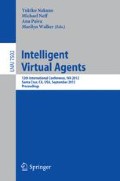Abstract
We have developed a novel methodology combining hierarchical task networks with traditional dialogue trees that both partially automates dialogue authoring and improves the degree of dialogue structure reuse. The key to this methodology is a lightweight utterance semantics derived from collaborative discourse theory, making it a step towards dialogue generation based on cognitive models rather than manual authoring. We have implemented an open-source tool, called Disco for Games (D4g), to support the methodology and present a fully worked example of using this tool to generate a dialogue about baseball.
Access this chapter
Tax calculation will be finalised at checkout
Purchases are for personal use only
Preview
Unable to display preview. Download preview PDF.
References
Bickmore, T., Schulman, D., Shaw, G.: DTask and LiteBody: Open Source, Standards-Based Tools for Building Web-Deployed Embodied Conversational Agents. In: Ruttkay, Z., Kipp, M., Nijholt, A., Vilhjálmsson, H.H. (eds.) IVA 2009. LNCS, vol. 5773, pp. 425–431. Springer, Heidelberg (2009)
Bickmore, T., Schulman, D., Sidner, C.: A reusable framework for health counseling dialogue systems based on a behavioral medicine ontology. J. Biomedical Informatics 44, 183–197 (2011)
Bohus, D., Rudnicky, A.: The RavenClaw dialog management framework: Architecture and systems. Computer Speech and Language 23(3), 332–361 (2009)
Despain, W.: Writing for Video Games: From FPS to RPG. A. K. Peters (2008)
Erol, K., Hendler, J., Nau, D.: HTN planning: Complexity and expressivity. In: Proc. 12th National Conf. on Artificial Intelligence, Seattle, WA (July 1994)
Grosz, B.J., Sidner, C.L.: Plans for discourse. In: Cohen, P.R., Morgan, J.L., Pollack, M.E. (eds.) Intentions and Communication, pp. 417–444. MIT Press, Cambridge (1990)
Hanson, P., Rich, C.: A non-modal approach to integrating dialogue and action. In: Proc. 6th AAAI Artificial Intelligence and Interactive Digital Entertainment Conf., Palo Alto, CA (October 2010)
Lochbaum, K.E.: A collaborative planning model of intentional structure. Computational Linguistics 24(4), 525–572 (1998)
Orkin, J., Smith, T., Roy, D.: Behavior compilation for ai in games. In: Proc. 6th AAAI Artificial Intelligence and Interactive Digital Entertainment Conf., Palo Alto, CA, pp. 162–167 (October 2010)
Rich, C.: Building task-based user interfaces with ANSI/CEA-2018. IEEE Computer 42(8), 20–27 (2009)
Rich, C., Lesh, N., Rickel, J., Garland, A.: A plug-in architecture for generating collaborative agent responses. In: Proc. 1st Int. J. Conf. on Autonomous Agents and Multiagent Systems, Bologna, Italy (July 2002)
Rich, C., Sidner, C.: Collagen: A collaboration manager for software interface agents. User Modeling and User-Adapted Interaction 8(3/4), 315–350 (1998); reprinted in Haller, S., McRoy, S., Kobsa, A. (eds.): Computational Models of Mixed-Initiative Interaction, pp. 149–184. Kluwer Academic, Norwell (1999)
Rich, C., Sidner, C., Lesh, N.: Collagen: Applying collaborative discourse theory to human-computer interaction. AI Magazine 22(4), 15–25 (2001)
Rickel, J., Lesh, N., Rich, C., Sidner, C.L., Gertner, A.S.: Collaborative Discourse Theory as a Foundation for Tutorial Dialogue. In: Cerri, S.A., Gouardéres, G., Paraguaçu, F. (eds.) ITS 2002. LNCS, vol. 2363, pp. 542–551. Springer, Heidelberg (2002)
Sidner, C.L.: An artificial discourse language for collaborative negotiation. In: Proc. 12th Nat. Conf. on Artificial Intelligence, Seattle, WA, pp. 814–819 (August 1994)
Smith, C., Cavazza, M., Charlton, D., Zhang, L., Turunen, M., Hakulinen, J.: Integrating Planning and Dialogue in a Lifestyle Agent. In: Prendinger, H., Lester, J.C., Ishizuka, M. (eds.) IVA 2008. LNCS (LNAI), vol. 5208, pp. 146–153. Springer, Heidelberg (2008)
Author information
Authors and Affiliations
Editor information
Editors and Affiliations
Rights and permissions
Copyright information
© 2012 Springer-Verlag Berlin Heidelberg
About this paper
Cite this paper
Rich, C., Sidner, C.L. (2012). Using Collaborative Discourse Theory to Partially Automate Dialogue Tree Authoring. In: Nakano, Y., Neff, M., Paiva, A., Walker, M. (eds) Intelligent Virtual Agents. IVA 2012. Lecture Notes in Computer Science(), vol 7502. Springer, Berlin, Heidelberg. https://doi.org/10.1007/978-3-642-33197-8_34
Download citation
DOI: https://doi.org/10.1007/978-3-642-33197-8_34
Publisher Name: Springer, Berlin, Heidelberg
Print ISBN: 978-3-642-33196-1
Online ISBN: 978-3-642-33197-8
eBook Packages: Computer ScienceComputer Science (R0)

